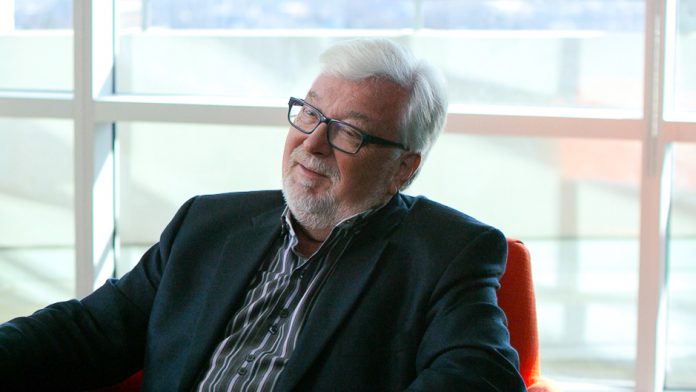Lee Bartel is a Professor of Music at the University of Toronto. We asked everything from why he chose his field of study to what’s on his playlist in hopes of giving you a better understanding of what goes on outside the lab for one of the best minds in Canadian research.
What inspired you to become a scientist?
Apparently as a child I drove my family nuts asking questions – mainly why questions – and I remember not getting adequate answers and starting to make my own answers – theories of sorts. Asking questions and making theories is the stuff of science – so when I gained an education I found science to be the most stimulating. So my first job when I left high school was as a lab chemist in a sugar factory, and after university I became a science teacher. I switched to music but the scientific questions never left me – and my most burning questions were around how people respond to music – how music affects people – and this at the University of Toronto led me to connect to health projects involving neural response. So it was not one incident or one person that led me to scientific research in music – it was an inner drive to find answers to “why” questions.
What do you like most about being a scientist?
I love the quest for theory – particularly interdisciplinary tracks of thought – seeing how previously unconnected ideas may link to form a new explanation.
What do you envision in the future of your field?
Dr. Rodolfo Llinas many years ago said, “Music is the machine language of the brain.” I think we are now starting to discover how that actually is the case. And I think the primary explanation lies in the interface of the rhythmicity of sound (including the molecular compression rhythmicity of pitched frequencies – e.g., A at 220 Hz is still a regular rhythmic phenomena at 220 times a second – as if we could hit a drum 220 times a second it would have the pitch of A) with oscillatory coherence in the brain. We are now seeing more attention to the higher frequencies of neural oscillation – and with that its connections to health states. I believe we will discover an important place for sound and music related to health in this way.
How will your research make a difference in our lives?
Music now seems pervasive and as Steven Pinker says seems merely like, “Cheesecake for the mind.” If we can find how precisely specific aspects of music, specific types of sound, affect our brain and body, this readily available and pleasant stimulant will become a potent “audioceutical.” Our study (David Alter and team) using enhanced beat effects in music for cardio rehab demonstrates that simple modifications of sound, and specific selection of music can make a remarkable difference in health outcomes. Without knowing it, people exercise more and develop better health effects. And this can be extended potentially to many other areas – Alzheimer’s prevention – or at least delay, pain reduction, etc.
What advice would you give young researchers?
Think broadly as well as deeply – the future will thrive on interdisciplinarity – tear down the silos – connect and collaborate.
What do you consider your greatest achievement?
This is the hardest to answer. I am hoping it will be the development at the University of Toronto of the Music and Health Research Collaboratory – for what it will accomplish in the future – but I don’t know how that will go. Conceptually it is probably the connection of vibroacoustics (low frequency sound stimulation), that was previously primarily considered a physiological stimulation, as a means to driving neural oscillatory activity – and the potential of that to re-regulate brain dysregulations – like thalamocortical dysrhythmia – and the potential of that to affect health conditions – like neurogenic pain, Parkinson’s, Alzheimers. We are just now pursuing that line of research with that theoretical frame – so it has not yet been adequately demonstrated – but the direction is established – and so I hope that will be productive. And if so, I would consider that my greatest achievement.
What do you read?
I read research papers in many fields – I am interested in many many things – I suffer from MID – Multiple Interest Disorder I think. In the more popular vein, I read avidly “The New Scientist” and Scientific American publications – to get a taste of many scientific fields. I am also a news junkie so I read, mostly online these days, News Republic, Huffington Post, The Star, the Globe & Mail, New York Times etc. And new books as they emerge – like Norman Doidge’s new book, “The Brain’s Way of Healing” etc.
What’s on your iPod? (Or if you’re like me and haven’t entered the 21st century, what records do you have?)
I do not use an iPod mainly because I do not like the quality of pixelated sound and low frequency response on the typical earphones. But I have a rack mount hard drive with my thousands of songs with a quite excellent sounds system. It has a very wide range of music – jazz, folk, folk rock, classical of various genre’s and periods – I particularly like chamber music. I range through country, gospel, pop, alternative – basically the full range – except I have very little “Hip hop”, no Dixieland jazz. I do also have a turntable and several thousand “records.”
If you could meet any historical figure who would it be and why?
Well, it would be great to meet and discuss ideas with someone like William James – father of modern psychology – philosopher – physician – the sort of inter-disciplinarian I admire – and get his take on the present state of the merger of disciplines that in a way he pragmatically created. I share his range of interests in psychology, philosophy, religion, mysticism, metaphysics etc.
But probably the person I would most like to meet is my great grandfather – written up in some local history books in southern Manitoba – he was a leader, innovator, early adopter to things like electricity, radio, telephone. He was also politically active – and the secretary liaison between local Mennonite population and the provincial and federal government. He was exceptionally well educated for his societal group. He was musical – and offended his church people with the use of the “technology” of using notation to remember the songs he was to lead. It was his example of innovator, thinker, “scientist” that was most powerful for me in my life – but always only through story – perhaps of mythical proportion. I would like to meet him to really understand how he viewed life and hear his stories of innovation. You can read more about him here: http://gameo.org/index.php?title=Rempel,_Johann_S._(1853-1929)
If you could do any profession other than your own what would it be?
I love the merger of the scientific and artistic – and so I have had great delight in my opportunities related to buildings – so I think I would choose to be an architect.
What do you like to do for fun?
I most enjoy learning and creating. So ideally I combine the two – learn something and create from it. I recently read about many forms of meditation – including walking the labyrinth – and then I learned about many different types of labyrinths and their history and use. I then designed a unique labyrinth and built a 65 ft diameter labyrinth surrounded by 65 globe cedars and the path dividers planted with lavender and cat mint, with a 3 rock “stone-henge type” sacred space in the middle. Creating it was fun – maintaining it – not so much. So I also enjoy travelling – seeing and learning new things.
Want to learn even more about Prof. Bartel? Check out his Orange Chair Interview.










































